Best Machine Learning Frameworks & Tools [with Real Life Examples]

Have you seen how some applications like Facebook and Netflix seem to instinctively ‘know’ things? Your friends automatically get tagged in your photos and you seem to get near accurate recommendations of movies and series you’d like to watch. How do you think that is happening?
These companies are making smart use of Machine Learning in their mobile applications to create a unique customer experience.
This technology enables mobile devices, including mobile phones and tablets to run software that can learn & react in real-time. This is one of the reasons that today we get brilliant user experience with some mobile apps. But before we get into that, let’s begin by understanding what Machine Learning is.
Table of Contents
What is Machine Learning?
Machine Learning is a field of Computer Science which lends the computer an ability to “learn” with data, without having to explicitly program it. It is essentially an application of Artificial Intelligence. Machine Learning focuses on developing computer programs that accesses data and use it to learn themselves.
What is Machine Learning Framework?
A Machine Learning Framework is a set of libraries or tools that makes it possible for a user to create machine learning models easily and quickly without having to worry about inner complexities and intricacies of the algorithm.
There are a number of machine learning frameworks in the market today which let developers create intelligent apps without the intervention of big data. These new age frameworks can be used to create intelligent apps with on device processing and minimal coding.
List of top Machine Learning Frameworks & Tools
- TensorFlow
- CAFFE (Convolutional Architecture for Fast Feature Embedding)
- The Microsoft Cognitive Toolkit/CNTK
- Torch/Pytorch
- MXNet
- Chainer
- Keras
- Deeplearning4J (DL4J)
- Sonnet
- Gluon
- Swift
- ONNX
- Apache Spark
- Scikit-Learn
- Apache Mahout
- Apache Singa
- Amazon Machine Learning
- NET
- Theano
- H2O
- Core ML
- Bender
- Quantized-CNN
- Apache PredictionIO
- Microsoft Distributed Machine Learning Toolkit
- OpenNN
#1 TensorFlow
TensorFlow, a popular framework from Google is particularly effective when it comes to creating Deep Learning models. Deep Learning is a class of Machine Learning that uses Artificial Neural Networks to make the systems learn and make improvements progressively to a task while considering examples typically without task-specific coding. The framework is based on computational graph which is essentially a network of nodes. Each node here is an operation that runs some function, as simple as a basic mathematical operation or as complex as multivariate analysis.
Examples of applications that use TensorFlow include Snapchat, Dropbox, Deepmind, Twitter, Uber, and Intel among others.
#2 CAFFE (Convolutional Architecture for Fast Feature Embedding)
CAFFE is one of the most popular Convolutional Neural Networks or CNNs that make tasks like image classification, machine vision, recommender system etc. a lot easier. The platform is particularly known for its Model Zoo – a pre-trained ML model that is capable of performing a great variety of tasks. The framework however doesn’t work for non-computer vision tasks including sound, time series, or text. The unique benefit of this framework is that it can be run on a multiple hardware and it only takes one single flag to switch between CPU and GPU.
#3 The Microsoft Cognitive Toolkit/CNTK
Formerly known as CNTK, Microsoft Cognitive Toolkit is great because it has a fairly easy training and a combination of many popular model types across servers. It is an open source deep learning framework that is perfect for the training of deep learning models. The framework is efficient in performing Convolution Neural Networks and training for image, speech, and text-based data. Quite like Caffe, this framework is supported by interfaces like Python, C++ and the Command Line Interface.
The framework is known for a coherent use of resources which makes it really easy to implement Reinforcement Learning models or Generative Adversarial Networks (GANs) with just their toolkit. The framework is preferred because of its high performance and scalability as compared to the competitors in the industry even while operating on multiple devices.
While using Microsoft Cognitive Toolkit, you don’t have to implement the new complex layer types in a low-level language because of the fine granularity of its building blocks.
Examples of apps that use Microsoft Cognitive Toolkit include Cortana, Bing, Xbox, and Skype among others.
#4 Torch/Pytorch

A scientific computing framework, Torch offers great support for machine learning algorithms. Torch is a Lua based deep learning framework that’s used among the industry giants including Facebook, Twitter, and Google. The framework employs CUDA along with C/C++ libraries for the processing. Pytorch has been accepted with a lot of enthusiasm within the deep learning framework community and is a worthy competitor of TensorFlow. PyTorch is essentially a port to Torch deep learning framework used for creating deep neural networks and executing highly complex tensor computations.
PyTorch runs on Python, so unlike Torch, Pytorch can be used by anyone who has a basic understanding of Python to start creating their own deep learning models. PyTorch’s architectural style means that their deep modeling process is a lot simpler and more transparent as compared to Torch.
Examples of companies that use Torch/Pytorch include Facebook, Google, Twitter, NYU, IDIAP, Purdue and a number of other companies and research labs.
#5 MXNet

The framework, MXNet was created with specific intent of attaining higher efficiency, productivity, and flexibility. The framework is supported by Python, R, C++, and Julia. MXNet is unique in giving users an ability to code in multiple programming languages including Python, C++, R, Julia, and Scala and more. This means that use the language you are comfortable working with, when you are training your deep learning models. As the backend is written in C++ and CUDA, MXNet is scalable and can work with a lot of GPUs, hence is indispensable for the organizations. As a framework, it supports Long Short-Term Memory (LSTM) networks in addition to both RNN and CNN. The framework is known for its ability in imaging, handwriting, speech recognition, forecasting as well as Natural Language Processing (NLP).
The most prominent name to adopt MXNet is Amazon Web Services.
#6 Chainer

Known for being really powerful, dynamic, and intuitive, Chainer is a deep learning framework for neural networks based on Python and is designed on the define by run strategy. Unlike their competitors using the same strategy, Chainer can modify the networks during runtime, letting you execute arbitrary control flow statements. The framework supports both, CUDA computation and multi-GPU and is used primarily for sentiment analysis, machine translation, speech recognition and more.
Some prominent companies that support Chainer include big names like IBM, Intel, Microsoft, NVIDIA, and Amazon Web Services.
#7 Keras

Keras, a neural networks library is known for being a minimalist. The framework uses Python as a supporting interface and extends support for both, convolutional and recurrent networks which have the ability to run either on TensorFlow or Theano. The USP of the library is the quick experimentation it allows. This low-level library can come across as a little complicated for new users because of the comparatively challenging TensorFlow interface. The intent behind building Keras was to offer a simplistic interface that can be used for quick prototyping by constructing effective neural networks that can work with TensorFlow. Keras is lightweight, is easy to use and is pretty simple when it comes to creating a deep learning model by stacking multiple layers. Keras is primarily used in classification, text generation and summarization, tagging, translation along with speech recognition among other great features. As a developer who has some experience working with Python, if you are looking to work with deep learning, Keras is the perfect choice for you.
Popular companies that use Kera include Verizon, IBM, Amgen, Netflix, Uber, Yelp, Instacart, Zocdoc, Square, and many others.
#8 Deeplearning4J (DL4J)

Deeplearning4J is a deep learning framework that is developed in Java and in Scala as well, and the best part is that it supports multiple other JVM languages as well. DL4J works as a commercial, industry-focused distributed deep learning platform.
One of the biggest advantages of the platform is that it can help you bring together the complete Java ecosystem for execution of deep learning. On top of that, the framework can be administered on top of Hadoop and Spark for orchestrating numerous host threads.
The framework offers a deep network support through Restricted Boltzmann Machine (RBM), Deep Boltzmann Machine (DBM), Convolution Neural Network (CNN), Recurrent Neural Network (RNN), Recursive Neural Tensor Network (RNTN) and Long Short-Term Memory (LSTM). As this framework is implemented in Java, it is inherently more efficient as compared to Python. Additionally, the framework shows an impressive potential for image recognition, fraud detection, text mining, parts of speech tagging, and natural language processing (NLP).
#9 Sonnet

This is a deep learning framework built atop TensorFlow and is designed particularly for creating neural networks with a complex architecture. Sonnet is primarily used to construct primary Python objects related to a particular section of the neural network. Additionally, these objects are connected independently to the computational TensorFlow graph. When you separate the process of creating objects and the process of associating the objects with a graph, you end up with a simplified design of a high-level architecture. This particular framework is essentially a flexible functional abstractions tool that is a great alternative to TensorFlow and PyTorch.
#10 Gluon

A brilliant deep learning framework, Gluon is great for creating both, simple and sophisticated models. A Gluon project characteristically has a flexible interface that makes the process of prototyping, building, and training deep learning models simpler without compromising on the learning speed. Based on MXNet, Gluon offers a simple API making the process of creating deep learning models simpler. Quite like the aforementioned PyTorch, Gluon also supports work with a dynamic graph. Further reinforced with the high-performance MXNet, Gluon presents itself as a great alternative to Keras when it comes to distributed computing.
Gluon lets you define neural networks with simple, clear, and concise code. This framework lets you define dynamic neural network models which means that the neural network models can be built on the fly, with any structure, while using any of Python’s native control flow.
#11 Swift

Though the language is primarily associated with iOS and MacOS app development, but Swift for TensorFlow is a popular choice in deep learning and is often abbreviated as S4TF. As it integrated with a general-purpose programming language, it lets really powerful algorithms to be expressed in a more effective way. In case your tasks cannot be accomplished with dynamic languages, this is a great choice for you!
#12 ONNX

Microsoft and Facebook collaborated and created the ONNX project – an open format for the presentation of deep learning models. It uses artificial intelligence to simplify the process of transferring models between multiple means of working. One of the best things about ONNX is that it lets you train models in one framework before transferring it to a different one for inference. Models based on ONNX are supported in Caffe2, Microsoft Cognitive Toolkit, MXNet, and PyTorch. In addition to this, the models can be run on multiple other frameworks and libraries with the help of connectors that are easily available.
#13 Apache Spark

Primarily written in languages like Java, Scala, R, and Python, Apache Spark is a cluster-computing framework. Since the framework has Spark RDD data structures there is no need to concern yourself with Numpy array. Also, the framework lets you work with Spark SQL frames. It has quite simple APIs for data scientists familiar with R & Python. The framework is scalable and capable of running machine learning code on small to large machines. The framework is chosen by most developers because it is streamlined end-to-end and compatible. Some of the most popular companies that use Apache Spark include Microsoft, IBM, Amazon, and Yahoo.
#14 Scikit-Learn

One of the most powerful Python libraries for machine learning coding, Scikit-Learn is used in the creation of Models. Scikit-Learn is built upon other libraries like SciPy, Numpy, and matplotlib. It’s a great tool when it comes to intent classification, regression, and clustering like statistical modeling. The framework includes both supervised and unsupervised learning algorithms and cross-validation. While the framework is written in Python, its core is in Cython for enhancing its performance. Scikit-Learn is really efficient for data mining and supports multiple practical tasks. It can deal with complex tasks with great ease and without compromising on speed.
Some of the top companies that use Scikit-Learn include big names like J P Morgan, Spotify, Inria, Evernote, and AWeber among others.
#15 Apache Mahout

A tool particularly designed for mathematicians, data scientists, and statisticians and lets the users execute their algorithms quickly. The framework is especially great when it comes to development of machine learning applications that are scalable and can act as a distributed linear algebra framework. The primary focus of the framework lies in filtering, collaborative grouping, and classification. Using Apache Mahout, developers can create their mathematical calculation in an interactive environment. Not only can the calculation be run on a Big Data platform but also can help you shift the same code in your applications and implementations. The framework offers a distributed linear algebra and statistic engine that works and distributes simultaneously along with an interactive shell and a library to link the application. Apache Mahout can climb onto Apache Hadoop using a map or reduce paradigm, but with enough freedom.
Some of the biggest companies that use Apache Mahout include AOL, Foursquare, Drupal, Intel, Twitter, Yahoo!, LinkedIn and more.
#16 Apache Singa

A framework that is considered to be the perfect option for Big Data analytics, Apache Singa is flexible and scalable for ML as it offers a flexible architecture for scalable distributed training for Big Data. This popular framework runs on a variety of hardware which means that it is extensible. The framework is applied primarily on Natural Language Processing (NLP) and image recognition. Also, the framework supports the more conventional machine learning models including regression. Some of the companies that use Apache Singa, include NetEase, yzBigDat, Shentilium and more.
#17 Amazon Machine Learning

The ecommerce and technology giant, Amazon has also tested the waters in the field of Machine Learning by offering its machine learning framework. Essentially, Amazon Machine Learning or AML is a collection of tools and wizards to build some really sophisticated, intelligent, and high-end applications without having to tweak the code.
AML offers prediction for your applications leveraging their APIs that are particularly easy-to-use. To create new models, you would need to carry out multiple operations, including regression, multi-class categorization, and binary classification. In such a situation AML lets you connect your applications to the cloud. Some of the best companies that use Amazon Machine Learning include Amazon, Audible, HealthTap and more.
#18 Accord.NET

Primarily used for scientific computing on Dot Net technologies, Accord.NET is a popular ML framework. The framework offers a variety of libraries for different applications including statistical data processing, image processing, linear algebra, and neural networks. The framework also has libraries which would be available as source code, installer, and NuGet packages. The framework’s matrix library inherently provides re-usability and slower algorithmic changes.
#19 Theano
It is a Python library which is unique in letting you define, optimize, and evaluate mathematical expressions which consist of efficiently using multi-dimensional arrays. Theano has an inherent ability to use GPUs and carry out efficient symbolic differentiation. Some of the companies that use Theano include DuPont, Vanguard, Verizon and many such others.
#20 H2O

Emerging from a grassroots culture of data transformation, H2O.ai has gained much popularity in the ML space. Their major Machine Learning product H2O is created with the aim to make ML easier for everyone. It is completely open source, distributed in-memory machine learning platform that has linear scalability. The platform supports most of the commonly used statistical and machine learning algorithms including gradient boosted machines, generalized linear models, deep learning and more. The platform is equipped with an industry leading AutoML functionality that runs automatically through all the algorithms and hyperparameters they have and creates a leaderboard for the top performers. Not only can you use a programming knowledge of your choice including R, Python etc. for building models in H2O, but can also use H2O Flow. H2O Flow is an interactive user interface which is based on a graphical notebook and does not need any coding. Some of the companies that use H2O include Verizon, Ericsson, eBay and more.
#21 Core ML

Introduced by Apple Inc. CoreML is a popular machine learning framework. Developers prefer this framework as it can help you integrate machine learning models locally on iOS devices. Additionally, the CoreML also supports frameworks like Vision for image analysis, natural language for NLP, speech to convert audio to text and sound analysis to identify sounds in audio.
#22 Bender

Bender has emerged as a promising framework and has a unique approach in addition to leveraging Apple’s Core ML. The framework uses the iPhone’s mobile GPU shaders toolkit called Metal Performance Shaders, which means that the iPhone users can run machine learning algorithms from their GPU. However, like Core ML, Bender too is still primarily used for running pre-trained data.
#23 Quantized-CNN
Quantized – as the name suggests, is a great framework for running convolutional neural networks. The framework offers simultaneous computation acceleration and model compression in the test phase. It also makes it possible for the mobile devices to perform efficient on-site image classification with negligible loss in accuracy.
#24 Apache PredictionIO

An open source Machine Learning Server, Apache PredictionIO is a great option for developers and data scientists who are working on creating predictive engines for any task based on machine learning. This unique Machine Learning Server is built on top of a state-of-the-art open source stack for the same purpose. The server makes it possible to amalgamate data from multiple platforms in batch or in real-time for comprehensive predictive analytics. Equipped with systematic processes and pre-built evaluation measures, this Machine Learning Server speeds up the process of machine learning modeling. Some of the companies that use Apace PredictionIO include Macy’s, Walmart, Verizon, among many others.
#25 Microsoft Distributed Machine Learning Toolkit

A comprehensive machine learning toolkit, Microsoft Distributed Machine Learning Toolkit contains highly scalable, efficient, and flexible machine learning tasks on big data. The toolkit also has a DMTK framework that offers support for a unified interface which makes data parallelization possible, a hybrid data structure for big model storage, model scheduling to ease big model training, and automatic pipelining to increase the efficiency of training. Apart from the flexibility it offers in communication facilities, it also offers friendly APIs and data-driven programming fashion.
#26 OpenNN

A free neural networks library for advanced analytics, OpenNN is known to solve multiple real-world applications in practical applications in varied niches including energy, marketing, health, and more. They have a specialized tool – Neural Designer that lets a developer create neural network models without having to get into programming. OpenNN has multiple sophisticated algorithms and utilities that can be used to deal with the following machine learning solutions including regression, classification, forecasting and association. Organizations that use OpenNN include names like Airbus, Philips, University of Washington, and more.
Examples of Top Machine Learning Mobile Apps
Machine Learning has managed to transform the expectations of the mobile device users and the way they interact with these devices. Most of the Startups and the tech giants are now beginning to see the benefits and scope offered by Machine Learning in mobile app development. It is this realization that have led to them coming up with some truly unique ideas. Here’s a list of top examples of machine learning mobile apps compiled by Appy Pie.
1) Snapchat

The filters by Snapchat are an amazing combination of augmented reality and machine learning algorithms for computer vision. Snapchat seriously considered the importance of Machine Learning only after their acquisition of Looksery, the Ukrainian computer vision company for a whopping $150 million.
How Snapchat incorporates Machine Learning?
Snapchat makes use of the unique facial tracking algorithm based on machine learning from Looksery to find faces in the snaps and add fun elements like glasses, hats, dog ears, and more!
Snapchat first detects a face, by looking at a photo as a set of data for the color value of each individual pixel. The program looks for areas of contrasts between light and dark parts of the image to determine which part of the picture is a face. Though the algorithm here doesn’t work when tilt your face acutely or face sideways but works really accurately for frontal faces.
Programming a computer explicitly to recognize a face is near impossible, because recognizing a face is very “human” ability, tough for a machine to emulate. The algorithm used in Snapchat looks at thousands of faces to slowly learn what a face looks like.
2) Oval Money
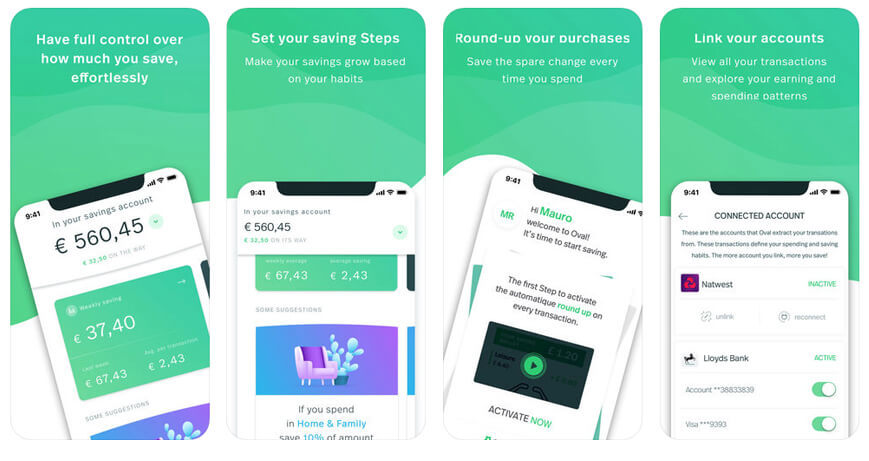
Oval Money is one of the greatest examples of a finance related mobile app that implements machine learning. The app, in fact uses machine learning to help you save money. Now, did we get your attention? The app combines machine learning with the lessons that the users can teach one another in order to build collective intelligence.
How Oval Money incorporates Machine Learning?
Oval keeps an eye on your spending habits and combines it with the collective knowledge from all other users and creates a smart and convenient money saving strategy customized especially for you.
The app is the superhero your finances need. It is only through Machine Learning that the app gains the ability to analyze the previous spending habits of the users and the transactional behavior of other users on the app. The strategies that the app suggests its users are based on this analysis and offers to its users, solutions in formats that are easy to follow in order to avoid spending extravagantly.
3) Pinterest

Pinterest is one of those interesting apps that have caught the attention of almost everyone who has ever dabbled with the social media, even if you are not a hardcore pinner. The core functionality here is to curate the content that exists on this platform, it is only natural that they’d prioritize investing in technologies that would make this process more effective.
How Pinterest incorporates Machine Learning?
In 2015, Pinterest acquired a Machine Learning company Kosei, and that led the company to leverage the potential of this promising technology. Kosei specialized in the commercial application of Machine Learning particular content discovery and recommendation algorithm, which made Kosei & Pinterest an ideal collaboration.
Since this collaboration, Machine Learning has managed to cast a positive impact on almost every aspect of the business operations of Pinterest, whether it is spam moderation, content discovery, advertising monetization, or reducing churn of email newsletter subscribers.
4) Tinder

The app that is known for finding you your soulmate – Tinder. How do they do it? Among all the spells and love potions, Tinder has been using one of the most cutting-edge technologies known to mankind today – Machine Learning. The particular element or application of Machine Learning that powers the matchmaking app Tinder is called ‘Smart Photos’. This feature is responsible for increasing the chances of a user finding themselves a match.
How Tinder incorporates Machine Learning?
The feature ‘Smart Photos’ with the help of Machine Learning technology, shows to people your photos in a random order and then analyzes the frequency of them being swiped right or left i.e. accepted or rejected. After a certain period of time, Tinder learns from these analyses which photos are more popular than the others and then reorders the photos to put popular photos first. This system of reordering photos hones itself over time and the extent of improvement that the system goes through is dependent on the input. This means the more input you feed into it, the better the system gets.
This effectively means that you would get better results and find your perfect match sooner than you think.
5) LeafSnap
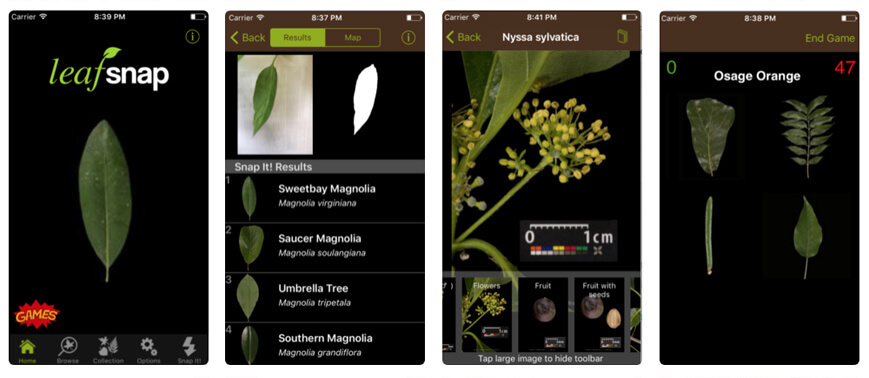
Don’t we all love Shazam? The app can simply hear a song and then tell you the artist and title! LeafSnap does the same for trees. The app is designed with the intent to help the botanists determine the species of the tree from a mere photo of a leaf.
How LeafSnap incorporates Machine Learning?
Leaves are one of the most common types of fossils, and it is quite a tough job to determine the species of this fossil. It is only after looking at thousands of photos of leaves, the algorithm of the app has learned to identify quite a few of them. Though Machine Learning has made it possible to identify thousands of leaves, however, the accuracy is still under scrutiny as mistakes are known to happen. It might not be 100% accurate, but LeafSnap is good enough to be a respectable and valuable tool for the scientists and is only improving with usage and time.
6) Dango
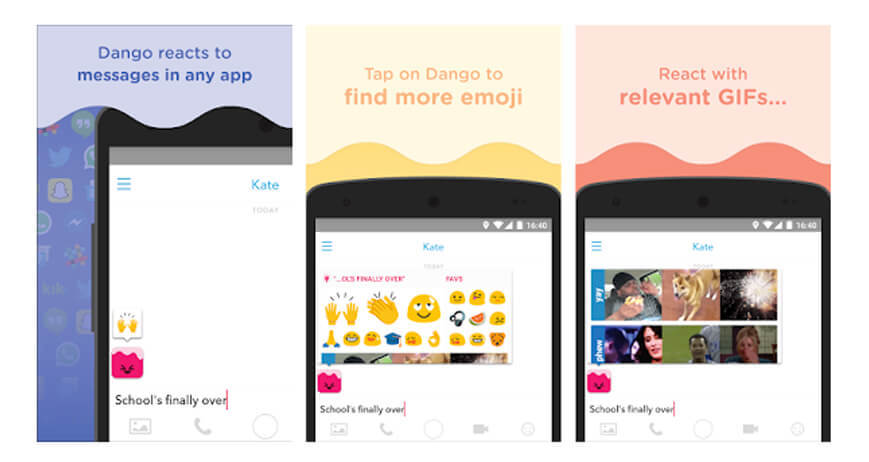 Though it may seem all about science and other such uninteresting things, but Machine Learning is a lot more than that. There are apps like Dango help you in finding the perfect emoji when you want it. Dango is not just any run of the mill app, it is, in fact a floating assistant that can be integrated into a number of different messengers.
Though it may seem all about science and other such uninteresting things, but Machine Learning is a lot more than that. There are apps like Dango help you in finding the perfect emoji when you want it. Dango is not just any run of the mill app, it is, in fact a floating assistant that can be integrated into a number of different messengers.
How Dango incorporates Machine Learning?
Once you integrate Dango into your messenger apps, it can predict the emojis, GIFs & stickers on the basis of what you are writing. In order to accomplish this, Dango needs to understand what you are trying to say through the words you are writing. Dango makes use of deep learning to train the neural networks so that it can understand the words. This training of the app begins with exploring millions of real-life examples of emoji usage and exposing the neural networks to them.
To begin with, all the neural networks can do is randomly take guesses at identifying emojis, however, with the passage of time and long-term use of the app, it develops the ability of matching millions of values becoming better in all its subsequent uses. As the app completes its training of the neural networks, it understands the emotions & jokes a lot better. This means that the more you use it, the more meaningful would be the suggestions for emojis and GIFs that would be offered to you.
7) Sea Hero Quest
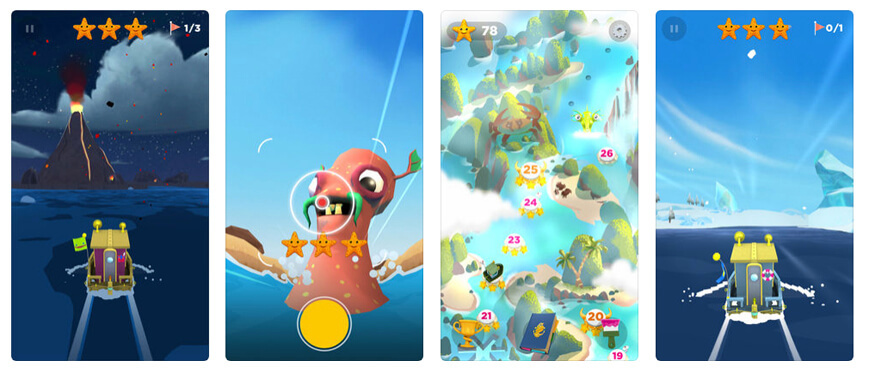
Sea Hero Quest is an entirely unique app that serves an entirely different purpose as compared to the rest of the apps on this list. The other apps use Machine Learning to power a cool feature, but Sea Hero Quest collects data from its users. This data that is collected from the users is then used by the scientists in order to machine learning software in order to further the research on Dementia.
How Sea Hero Quest incorporates Machine Learning?
The app makes use of a game format to make it interesting for the user. It is designed in such a manner that quite cleverly tests the spatial awareness of the player or the app user. Whenever you play the game, your scores and other information is relayed anonymously to the experts in order to gain a better understanding of the complex yet intriguing human brain. In case you didn’t get the repercussion, let us tell you that all you have to do is play this fabulously addictive game and do your bit in contributing towards furthering research into a condition that afflicts millions of people the world over.
8) Aipoly Vision
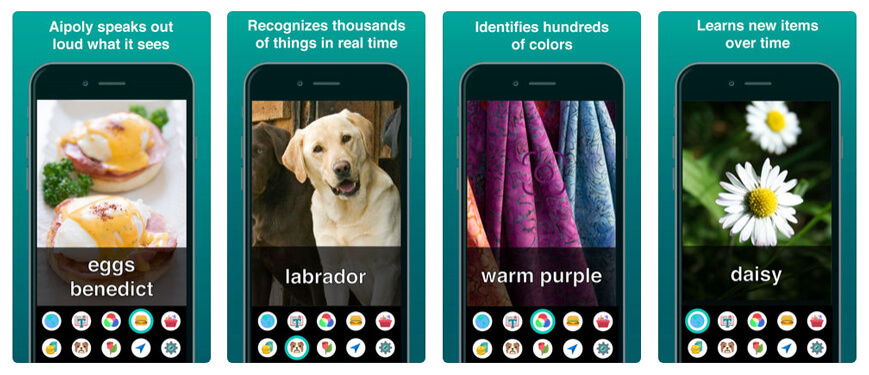
Human vision is massively superior to computer vision and there is no doubt about it. However, in the recent times computer vision has improved to a great degree and it is majorly due to the advancement in the application of Machine Learning in building mobile apps. Today Google Photos and other such apps have the ability to analyze an image and recognize what or who features in it, before tagging people.
How Aipoly Vision incorporates Machine Learning?
Aipoly is a whole lot more ambitious. This unique mobile app can recognize the objects that appear on your camera screen in real time. All you have to do is point your camera to an object and Aipoly would then tell you what the object is according to it. The idea behind building the app was to assist those who are visually impaired in accomplishing their everyday tasks with a relative ease. The app may not be even near perfect, but it is gradually getting a lot better and quite like the other machine learning mobile apps will continue getting better as people keep using it.
9) Netflix
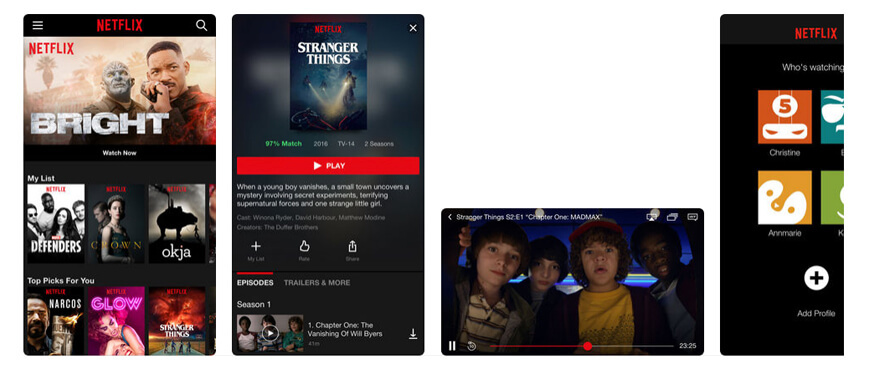
One of the most popular and obvious examples of Machine Learning is the mobile app for Netflix. The app is famous for knowing what you want to watch even before you know that you want to watch. It might seem magical, but is it? It is Machine Learning that has enabled Netflix to grow from a DVD rental website to a global streaming device.
How Netflix incorporates Machine Learning?
Netflix has managed to perfect its personalized recommendations by means of machine learning algorithms including Linear Regression, Logistic Regression, & more. The content on the app is categorized on the basis of genre, actors, reviews, length, year, etc. and all this usage data goes into machine learning algorithms. The machine learning algorithms learn from the users’ behaviors in order to come up with highly personalized recommendations and suggestions.
10) Twitter
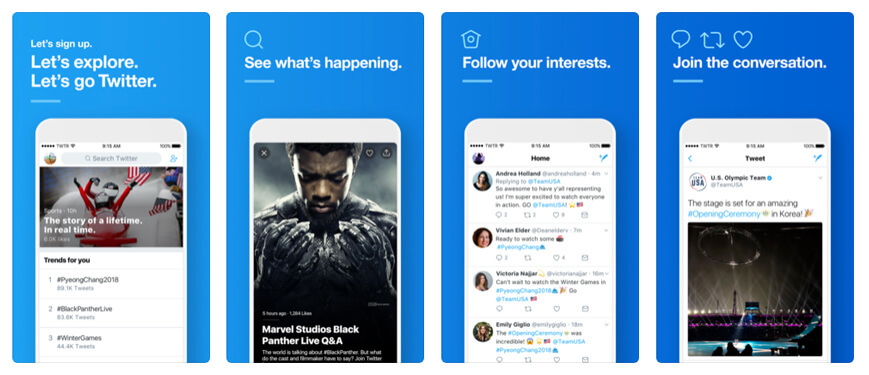 Twitter might have been chastised by the users for their decision to round out everyone’s avatars or the change in way people were tagged in replies, but one change that has managed to capture the attention of the users is their progression towards an algorithmic feed.
Twitter might have been chastised by the users for their decision to round out everyone’s avatars or the change in way people were tagged in replies, but one change that has managed to capture the attention of the users is their progression towards an algorithmic feed.
How Twitter incorporates Machine Learning?
In your Twitter feed you might prefer looking at the ‘best Tweets’ first or go through the Tweets in a logical, chronological manner, what you see is essentially being decided through machine learning. The Machine Learning algorithm evaluates each Tweet being posted on the app and uses a variety of metrics in order to score it.
Eventually the point of this whole exercise is to display tweets that are expected to drive a higher engagement. This decision is taken on an individual basis as the machine learning technology behind this new feature in Twitter makes these decisions based on the individual preferences of the users. This is what creates the new algorithmic feed.
11) Google Maps
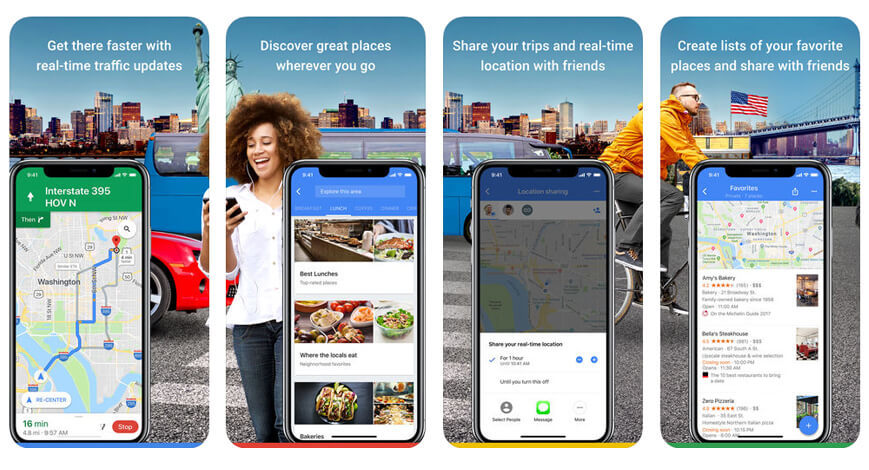
How many times have you struggled to find a parking spot for yourself? I am guessing it is more than once! Google Maps the app has come up with a way to help ease this pain and help you find a parking spot. How do they do it? Simple – through analysis of data that the app has gathered. The researchers at Google have gathered and analyzed data from more than 100,000 people by asking questions like “How long did it take you to find parking?” & more.
How Google Maps incorporates Machine Learning?
Further, in order to create training models, anonymous aggregated information is used from the users who have agreed to share their location data. This means that if such a user keeps circling around, after reaching their destination, it indicates that finding a parking spot in that area is tough. The app makes use of a standard logistic regression model to design features that then predict the difficulty or ease in finding an empty parking spot.
12) Yelp

So, you tried the new restaurant in town, and hated it, what do you do? You go to Yelp and vent out in a review about them. To begin with, Yelp might not have been considered as one of the tech companies, but in the recent years, it has managed to apply Machine Learning in interesting ways and enhanced user experiences.
How Yelp incorporates Machine Learning?
It was only recently that Yelp got into machine learning by implementing picture classification technology. It is through machine learning that the human employees at Yelp can accumulate, classify, and label images efficiently and with great ease. This is a huge help considering that you would have to deal with millions and millions of images.
13) Carat App
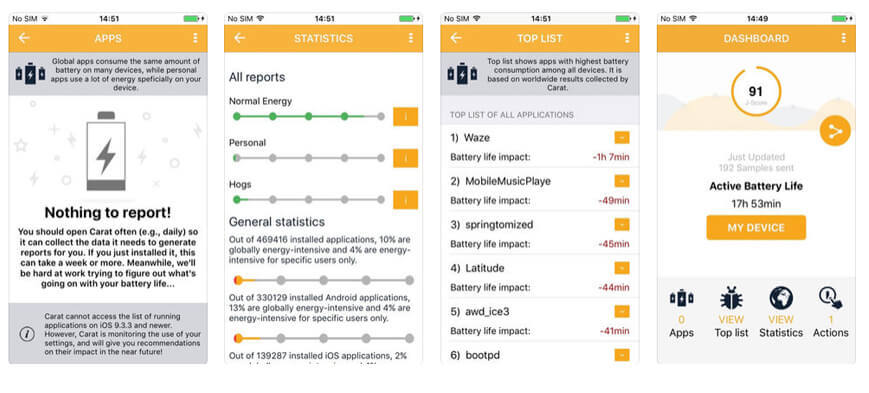
The battery life of our mobile devices has been a cause of worry and grief for most of us at some point of time. There are a whole lot of developments taking place in this contemporary world, but power storage doesn’t seem to be an area that is keeping pace with the rest. Hence, some of the app developers began looking at other ways of enhancing the battery life of the devices.
How Carat App incorporates Machine Learning?
The obvious suggestions like “Turn down screen brightness” just do not do enough. Carat is a Machine Learning based app that monitors all kinds of activities that you use your mobile device for, and then offers you suggestions on ways to reduce the power usage. The app was developed by Ph.D. students uses machine learning to learn how you use your phone to be able to alert you whenever there is a problem. In addition to giving you power saving suggestions, the app also notifies you when an app is broken & needs to be downloaded yet again & alerting you when your phone needs to be restarted.
14) ImprompDo
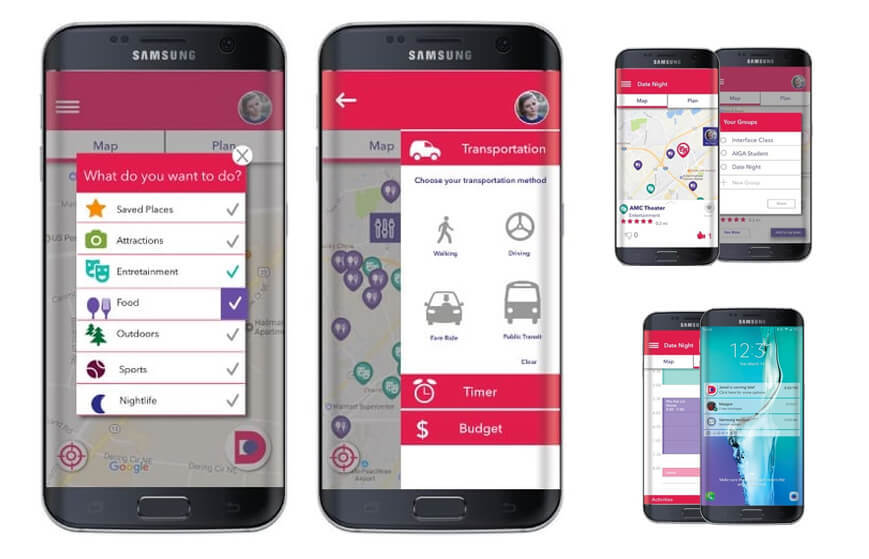
When you are fighting your habit of procrastination, ImprompDo can actually do wonders! The app helps people get things done without a demanding schedule. The app is great at finding that coveted balance which harmonizes between your to-do list and all the time that you have, finding you a suitable moment for you to accomplish the important tasks.
How ImprompDo incorporates Machine Learning?
It takes a while for the app to work perfectly so that it has the time to learn how you manage your time efficiently and monitors your location while you are doing it. This can further help the app in prioritizing your to-do list for you!
Conclusion
Machine Learning is neither a frivolous term, nor is it a far-fetched science fiction stuff anymore! It is very real and has found application in everything from entertainment to the more serious, real world scenarios.
The set of machine learning frameworks mentioned above have their own particular characteristics and functionalities which make them suitable for different apps.
Which framework works the best for you? Tell us in the comments section which one you chose; we’d love to hear from you. Meanwhile you can find out how you can create an app yourself by going to Appy Pie.
Related Articles
- How to Design a Certificate? [Step-by-Step Guide]
- Fancy Font Generator- What are Fonts, their Uses & How to generate Stylish Texts?
- How to Launch Your App in an International Market?
- App Maker Disney to Open New Star Wars Resort Hotel featuring Behind the Scene Video of the Last Jedi
- Best Free Survey Tools to Use in 2023
- How to Create a Ride Sharing App Like Uber? [Features, Benefits, and Steps]
- How to Become a Successful Entrepreneur?
- Networking in Swift with URLSession
- How to start an app development company? [7 Critical Points]
- How to start your own Podcast – The Ultimate Guide for Beginners
Most Popular Posts
 Photoshop Alternatives: Top 10 Graphic Design Tools in 2024
Photoshop Alternatives: Top 10 Graphic Design Tools in 2024 By Deepak Kumar | July 25, 2024
 Canva vs Appy Pie Design – Which is Better?
Canva vs Appy Pie Design – Which is Better? By anupam | July 18, 2024
 Canva Alternatives: Top 15 Graphic Design Tools to Replace Canva in 2024
Canva Alternatives: Top 15 Graphic Design Tools to Replace Canva in 2024 By anupam | July 18, 2024
 Canva Review: Key Features, Pros, Cons & Pricing
Canva Review: Key Features, Pros, Cons & Pricing By anupam | July 18, 2024
 8 Best ManyChat Alternatives in 2024
8 Best ManyChat Alternatives in 2024 By Samarpit Nasa | July 12, 2024




